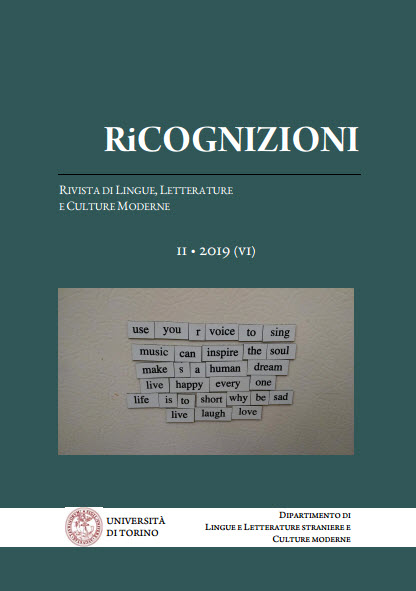PROSODIC STRUCTURE AND POETIC DICTION
DOI:
https://doi.org/10.13135/2384-8987/3292Keywords:
intonation, prosodic structure, stress group, brain waves.Abstract
Speech styles are particularly characterized by prosodic features, such as rhythm, melody, intensity or vowel quality, which indicate to the listener emotions, attitudes, sociogeographic origin of the speaker. Whatever the speech style, there are some unsuspected rules that are always applied, linked to specific cognitive properties of the brain. Among these, the necessity to segment speech units in chunks called stress groups and assemble these groups into a prosodic structure. Both stress groups duration and their hierarchical organization into a structure are constrained by theta and delta brain waves timing properties. Examples of these limits are illustrated in acoustic analysis of poetic diction showing that whatever the style adopted by readers, cognitive constrains are always observed.
References
Acheson D. J. and Maryellen C. MacDonald (2009) Verbal Working Memory and Language Production: Common Approaches to the Serial Ordering of Verbal Information, Psychol Bull. 2009 January; 135(1): 50–68.
Artaud, A. (1947) https://www.youtube.com/watch?v=oiScQ2wG3WU
Bally, Ch. (1944) Linguistique générale et linguistique française, Berne : Francke,
Delattre P. (1966) Les dix intonations de base du français, French Review 40, 1966, 1-14.
Ghitza, Oded (2011) Linking speech perception and neurophysiology: speech decoding guided by cascaded oscillators locked to the input rhythm, Frontiers in Psychol. 2, 130.
Léon, Pierre (1993) Précis de phonostylistique : parole et expressivité, Paris : Nathan Université, Série « linguistique », 1993
Martin Ph. (2014) Spontaneous speech corpus data validates prosodic constraints, Proceedings of the 6th conference on speech prosody, Campbell, Gibbon, and Hirst (eds.), 2014, 525-529.
Martin, Ph. (2013) Émotions et structure prosodique : qui domine qui ?, Cartographie des émotions, F. Baider et G. Cislaru éd., Paris : Presses universitaires de la Sorbonne.
Nowak, Paul (2012) Speed reading tips: 5 ways to minimize subvocalization, http://www.irisreading.com/speed-reading/speed-reading-tips-5-ways-to-minimize-subvocalization/
Martin Ph. (2018) Intonation, structure prosodique et ondes cérébrales, London : ISTE, 322 p.
Rossi, M. Le seuil de glissando ou seuil de perception des variations tonales pour la parole. Phonetica. n° 23, 1971, 1-33.
Quercia P. (2010) Ocular movements and reading: a review, J. Fr. Ophtalmologie, 33 (6): 416-423.
WinPitch (2019) Logiciel d’analyse de la parole. www.winpitch.com
Wheaton College (2019) (https://wheatoncollege.edu/vive-voix/titres/lalbatros/).
Downloads
Additional Files
Published
How to Cite
Issue
Section
License
RiCognizioni is published under a Creative Commons Attribution 4.0 International License.
With the licence CC-BY, authors retain the copyright, allowing anyone to download, reuse, re-print, modify, distribute and/or copy their contribution. The work must be properly attributed to its author.
It is not necessary to ask further permissions both to author or journal board.








